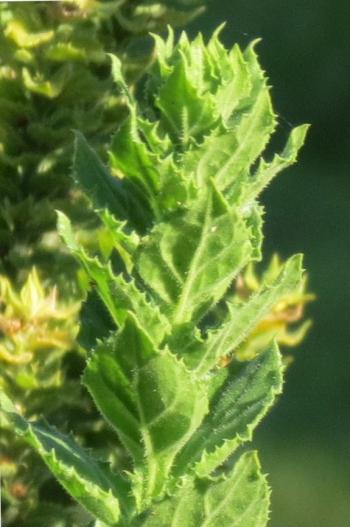Oftia africana
Oftia africana (L.) Bocq.
Family: Scrophulariaceae
Common names: lazy bush (Eng.); koekblommetjiesbos, sukkelbossie (Afr.)
Introduction
Rough to the touch, this shrublet has pretty white flowers that have a sweet, chocolaty fragrance.

Description
Description
Oftia africana is a small shrub with an upright and sprawling growth habit. It has trailing branches, up to 1 m long and often forms small thickets, numerous metres across. The stem is multi-branched and matures to brown, with hardwood including the young stems of the plant. The leaves are alternate, all around the stem, stalkless, glossy and green, but appear grey because of the hairs found on the undersides of the leaves, as well as on the stem. The narrowly egg-shaped leaves are small, 10–15 mm long and 5–10 mm wide , with the margins sharply toothed.

The shrublet bears white, chocolate-scented flowers, that are solitary in the axils of upper leaves. The flowers have a pale green floral tube that is hairy in the throat and white petal lobes that have a purple tinge on each petal, spreading and somewhat curved back. The shrublet flowers sporadically during the year, but peaks in winter, from May to July. The fruits are stalkless, solitary green berries, and appear while the shrub is in flower.

Conservation Status
Status
According to the Red List of South African plants, the conservation status of this species is Least Concern (LC), meaning that it is not threatened in its natural habitat.

Distribution and habitat
Distribution description
This is a South African endemic. It is widely distributed in the Eastern, Northern and Western Cape. It occurs on rocky sandstone and granite slopes.

Derivation of name and historical aspects
History
The derivation of the name Oftia is obscure and unexplained by Michel Adanson (1727–1806), the French botanist who authored it. Jackson suggests that Adanson might have named the genus for some friend, a M. Oft, but Charters found no evidence either for that theory or for any other, but ponders that in old versions of printing, the letter ‘s’ was written almost the way the letter ‘f’ is written today, and given the fact that Ostia is a geographical location (at the mouth of the river Tiber), it is possible that someone misread Ostia as Oftia? But why he would name a South African endemic plant after a site in Italy, is equally obscure.
The specific name africana, means ‘African’.
The genus Oftia is in the family Scrophulariaceae in the major group Angiosperms or flowering plants. This genus has 3 species, which include O. africana, O. glabra, a rare species from the Witteberg and Warmwatersberg in the Western Cape, and O. revoluta, from the Northern Cape.
Ecology
Ecology
The sweet chocolate scent of the flowers attracts small insects, butterflies and ants. The berries attract fruit-eating birds.
Uses
Use
There are no recorded medicinal or traditional uses for Oftia africana.
Growing Oftia africana
Grow
Oftia africana may be grown from cuttings (stem, tip and heel), taken from the new growth, using rooting hormone suitable for semi-hardwood or hardwood cuttings, placed in a mixture of river sand and milled bark. The cuttings can be taken throughout the year and once rooted, should be planted in a general soil mixture, such as 4 parts compost to 3 parts milled bark and 1 part sand. Root formation usually takes between 10–22 days. Rooted cuttings may be hardened off by exposing them to more light and reducing the supply of water.
This plant will do well in full sun, although it can also take semi shade, best with afternoon sun. The chocolate-scented flowers make this a perfect addition to a fragrant garden and will easily attract insects and birds. Use shrubs for screening in the garden. It is also drought hardy so it can be used in water-wise gardens. Regular pruning will keep the bush nice and tidy, as it can get untidy, woody and brown, if left unattended. Use this plant as a filler in between and amongst plants in the garden, and it makes a great a companion plant in a Fynbos garden.
References
- Charters, M.L. 2006–2016. The Eponym Dictionary of South African plants. Published online at http://www.calflora.net/southafrica/1Titlepage.html
- Jackson, W.P.U. 1990. Origins and meanings of names of South African plant genera. University of Cape Town.
- Manning, J. 2007. Field guide to Fynbos. Struik Publishers, Cape Town.
- Manning, J. & Goldblatt, P. 2012. Plants of the Greater Cape Floristic Region 1: the Core Cape Flora. Strelitzia 29. South African National Biodiversity Institute, Pretoria.
- Trinder-Smith, T.H. 2006. Wild flowers of the Table Mountain National Park. Associated Printing, ??? .
Credits
Sisanda Alakhe Velembo
Kirstenbosch National Botanical Garden
July 2017
Plant Attributes:
Plant Type: Ground Cover, Shrub
SA Distribution: Eastern Cape, Northern Cape, Western Cape
Soil type: Sandy, Loam
Flowering season: Winter
PH: Acid, Neutral
Flower colour: White
Aspect: Full Sun
Gardening skill: Average
Special Features:
Horticultural zones








Rate this article
Article well written and informative
Rate this plant
Is this an interesting plant?
Login to add your Comment
Back to topNot registered yet? Click here to register.